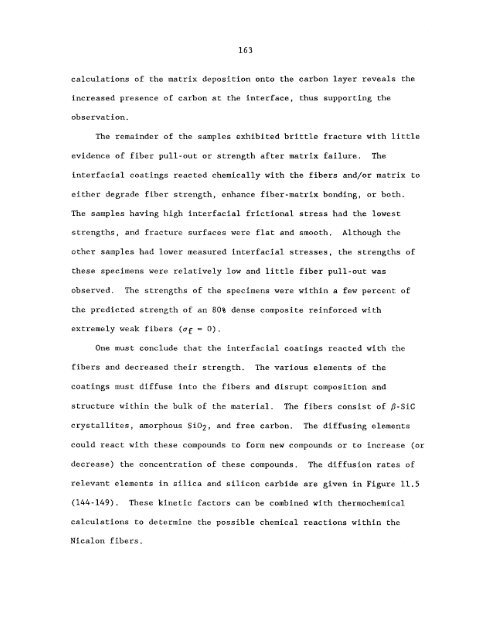Characterization and control of the fiber-matrix interface in ceramic ...
Characterization and control of the fiber-matrix interface in ceramic ...
Characterization and control of the fiber-matrix interface in ceramic ...
Create successful ePaper yourself
Turn your PDF publications into a flip-book with our unique Google optimized e-Paper software.
163<br />
calculations <strong>of</strong> <strong>the</strong> <strong>matrix</strong> deposition onto <strong>the</strong> carbon layer reveals <strong>the</strong><br />
<strong>in</strong>creased presence <strong>of</strong> carbon at <strong>the</strong> <strong><strong>in</strong>terface</strong>, thus support<strong>in</strong>g <strong>the</strong><br />
observation.<br />
The rema<strong>in</strong>der <strong>of</strong> <strong>the</strong> samples exhibited brittle fracture with little<br />
evidence <strong>of</strong> <strong>fiber</strong> pull-out or strength after <strong>matrix</strong> failure.<br />
The<br />
<strong>in</strong>terfacial coat<strong>in</strong>gs reacted chemically with <strong>the</strong> <strong>fiber</strong>s <strong>and</strong>/or <strong>matrix</strong> to<br />
ei<strong>the</strong>r degrade <strong>fiber</strong> strength, enhance <strong>fiber</strong>-<strong>matrix</strong> bond<strong>in</strong>g, or both.<br />
The samples hav<strong>in</strong>g high <strong>in</strong>terfacial frictional stress had <strong>the</strong> lowest<br />
strengths, <strong>and</strong> fracture surfaces were flat <strong>and</strong> smooth. Although <strong>the</strong><br />
o<strong>the</strong>r samples had lower measured <strong>in</strong>terfacial stresses, <strong>the</strong> strengths <strong>of</strong><br />
<strong>the</strong>se specimens were relatively low <strong>and</strong> little <strong>fiber</strong> pull-out was<br />
observed.<br />
The strengths <strong>of</strong> <strong>the</strong> specimens were with<strong>in</strong> a few percent <strong>of</strong><br />
<strong>the</strong> predicted strength <strong>of</strong> an 80% dense composite re<strong>in</strong>forced with<br />
extremely weak <strong>fiber</strong>s (uf = 0).<br />
One must conclude that <strong>the</strong> <strong>in</strong>terfacial coat<strong>in</strong>gs reacted with <strong>the</strong><br />
<strong>fiber</strong>s <strong>and</strong> decreased <strong>the</strong>ir strength. The various elements <strong>of</strong> <strong>the</strong><br />
coat<strong>in</strong>gs must diffuse <strong>in</strong>to <strong>the</strong> <strong>fiber</strong>s <strong>and</strong> disrupt composition <strong>and</strong><br />
structure with<strong>in</strong> <strong>the</strong> bulk <strong>of</strong> <strong>the</strong> material. The <strong>fiber</strong>s consist <strong>of</strong> p-Sic<br />
crystallites, amorphous Si02, <strong>and</strong> free carbon. The diffus<strong>in</strong>g elements<br />
could react with <strong>the</strong>se compounds to form new compounds or to <strong>in</strong>crease (or<br />
decrease) <strong>the</strong> concentration <strong>of</strong> <strong>the</strong>se compounds. The diffusion rates <strong>of</strong><br />
relevant elements <strong>in</strong> silica <strong>and</strong> silicon carbide are given <strong>in</strong> Figure 11.5<br />
(144-149). These k<strong>in</strong>etic factors can be comb<strong>in</strong>ed with <strong>the</strong>rmochemical<br />
calculations to determ<strong>in</strong>e <strong>the</strong> possible chemical reactions with<strong>in</strong> <strong>the</strong><br />
Nicalon <strong>fiber</strong>s .

















